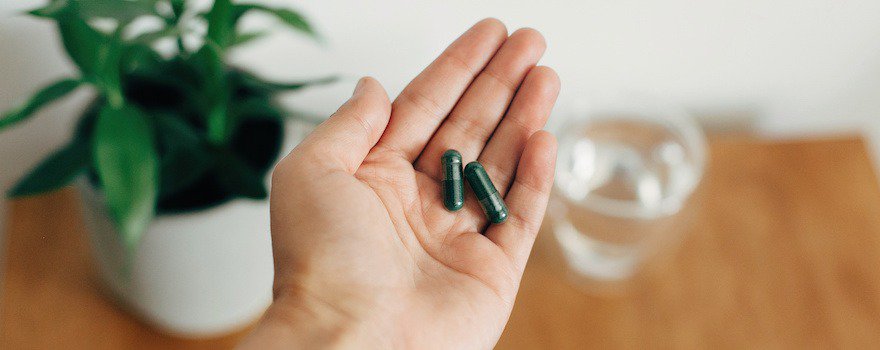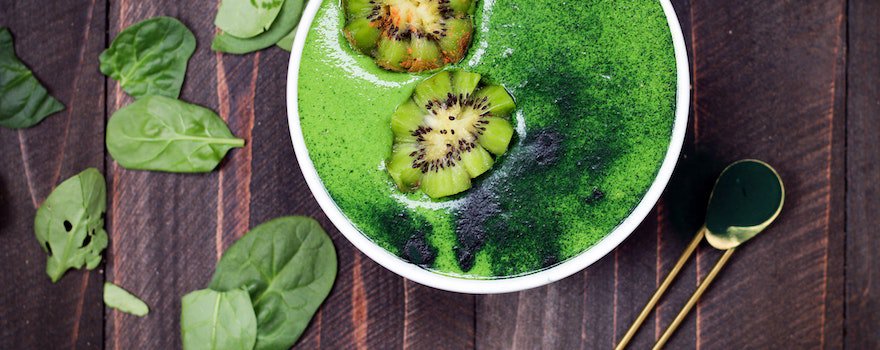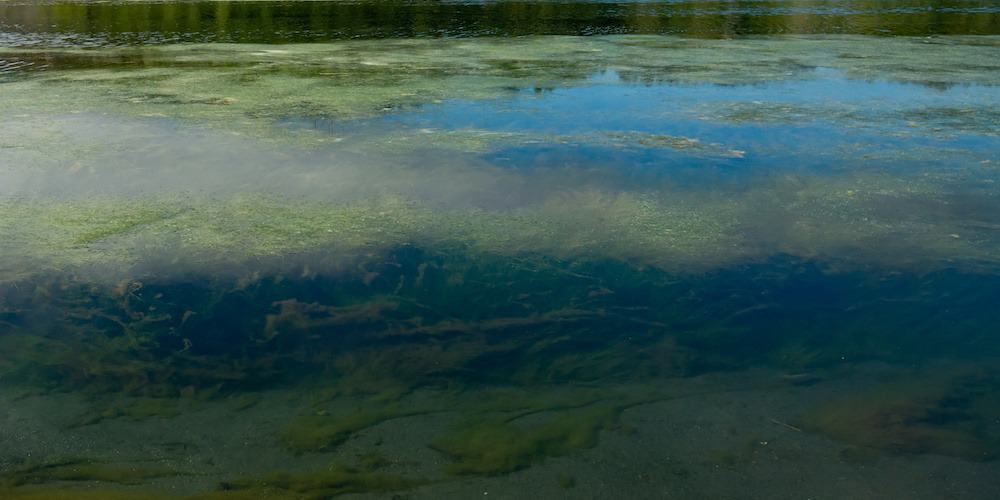What is Klamath?
Like the spirulina (Arthrospira platensis) or the chlorella (Chlorella vulgaris), Klamath is not strictly an algae but a cyanobacterium (also called « micro-alga » or « blue-green algae »). This phylum of bacteria is distinguished by its ability to perform photosynthesis and by its chlorophyll content.
Klamath, with the scientific name Aphanizomenon flos-aquae, is a microalga native to Upper Klamath Lake in Oregon, in the northwest of the United States. It thrives there in abundance because it finds in these fresh, pure, and preserved waters all the conditions necessary for its development.
Klamath is a filamentous cyanobacterium that grows on the surface of the water and resembles a blade of grass. Its blue-green color is due to the presence of chlorophyll and pigments such as phycocyanins.
Without a nucleus, Klamath is nevertheless endowed with highly efficient cells, called heterocytes, which allow it to carry out photosynthesis by fixing atmospheric nitrogen. It also has akinetes, resistant cells that take over when conditions are unfavorable: cold, low light, lack of nutrients…

Although it is not known precisely its traditional use, it is believed to have been consumed for a long time by the Klamath tribe, a Native American people of Oregon. It was finally in the 1990s that its consumption began to increase. The annual production from Klamath Lake then reached more than one ton. Numerous scientific studies then contributed to its popularization worldwide.
It contains no fewer than 20 amino acids and 14 vitamins, as well as minerals, trace elements, and other natural compounds.
Today, Klamath is primarily consumed as a dietary supplement, in capsules, tablets, flakes or powder. Its exceptional composition makes it a very interesting superfood for regenerating the body, stimulating immune surveillance (a process that allows the immune system to monitor pathogenic cells), preventing deficiencies and relieving depression.
Nutritional composition
- 20 acides aminés dont 10 essentiels : arginine, histidine, isoleucine, leucine, lysine, méthionine, phénylalanine, thréonine, tryptophane, valine
- 14 vitamines : A, C, E, B1, B2, B3, B6, B8, B12, K…
- Minéraux et oligo-éléments : calcium, cuivre, potassium, zinc, magnésium, fer, germanium, sélénium…
- Phényléthylamine
- Protéines
- Pigments antioxydants : phycocyanine, bêtacarotène et caroténoïdes
- Acides gras insaturés : oméga 3, oméga 6
- Chlorophylle
- Polyphénols
- Polysaccharides
- Peptides
- Lipides

The benefits of Klamath
🛡 Activates immune surveillance
Klamath does not directly stimulate lymphocytes (white blood cells) but activates immune surveillance. Immune surveillance is a natural physiological function of the body that enables continuous monitoring and recognition of pathogens. It is therefore through this early immune surveillance that the body’s immune defenses are set in motion.
This property is due to the phycocyanin, an immunomodulatory pigment contained in this microalga and also present in spirulina. At the same time, other compounds in the microalga contribute to the proper functioning of the immune system : iron, selenium, zinc, vitamin C…
This study from McGill University in Montreal, conducted on volunteers, shows the positive effects of consuming klamath on the immune system.
🧘🏽♀️ Relieves depression and contributes to mental well-being
Klamath doesn’t act only on the physical : it’s also an interesting superfood for improving one’s mental well-being. Its consumption is recommended in cases of depression or temporary low mood, mental fatigue, or difficulty concentrating…
The microalga contains valuable compounds known for their effects on the nervous system. It notably contains a significant amount of vitamin B12 (4-6 mcg/g of which at least 1 mcg/g is bioavailable) and tryptophan (15 mg/g).
Vitamin B12 helps, among other things, to reduce mood disorders. A B12 deficiency may lead to depression. Tryptophan, for its part, directly contributes to the formation of serotonin, also known as the “happiness hormone”.
Finally, Klamath contains phenylethylamine (PEA), a substance naturally produced by the body. Also called the ‘love molecule’, it produces an intense feeling of well-being. Phenylethylamine has also been shown to be effective in the treatment of behavioral disorders.
This study from various Italian universities, conducted on patients suffering from attention deficit/hyperactivity disorder (ADHD), shows the potential of the phenylethylamine contained in Klamath to improve the symptoms of the condition (inattention, impulsivity…).
🥝 Fights free radicals
Klamath is a food with antioxidant properties. Its content of beta-carotene, phycocyanin, polyphenols and vitamin C allows it to effectively fight free radicals. Thus, its consumption prevents oxidative damage to cells.
The microalga acts effectively against oxidative stress caused by an excess of free radicals in the body. It is notably involved in the development of age-related diseases and conditions linked to aging, such as Alzheimer’s disease.
This study from the National Scientific Research Center in Havana, Cuba, conducted on mice, demonstrates the scavenging action and antioxidant properties of phycocyanin from blue-green algae on free radicals.
This other study from the University of Palermo in Italy, conducted directly on bioactive molecules, examined the potential of Klamath in preventing oxidative stress.
🍽 Prevents deficiencies
Klamath is considered one of the most nutritious superfoods in the world. Indeed, it is rare to find so many bioavailable nutrients in a single food. Amino acids alone account for more than 50 % of Klamath’s weight.
Consumption of Klamath is particularly recommended for vegetarians or vegans to prevent deficiencies in iron, vitamin B12 (but in amounts too small to completely do without supplementation), and omega-3 and omega-6 fatty acids. It also provides a rich source of plant protein.
This study from the Institute of Biomedicine and Molecular Immunology of Palermo in Italy, conducted directly on cells, sheds more light on the composition of Klamath.
♾ Promotes the production of stem cells
Klamath has the specific property of stimulating the production of our own stem cells. These cells are in fact the “mother cells” of all the organs and tissues of the human body. They are responsible for their formation but also for the creation of ‘sub-cells’ in each organ and tissue. Stem cells are also capable of repairing damaged organs or tissues.
Inside the body, stem cells multiply indefinitely. But age, free radicals, illnesses… reduce their capacity to proliferate and restore. By promoting the production of stem cells, klamath supports the regeneration of organs and tissues.
This study from the University of South Florida in the United States, conducted on human cells, examined the effect of klamath on stem cell proliferation.

How to consume Klamath?
Klamath in tablets
Klamath tablets or capsules are the simplest form to take and the easiest to find on the market. This type of dietary supplement also has the advantage of having no taste. Indeed, klamath has a strong smell and a very pronounced seaweed flavor that may not appeal to everyone…
Preferably choose capsules containing 100% natural klamath and/or certified organic, non-GMO, without additives or preservatives.

Klamath flakes
Klamath can be found in flakes, that is to say dehydrated seaweed. It’s a fairly natural and minimally processed form that preserves its nutritional richness well. As with capsules, check the composition carefully and favor klamath from organic farming.
If you enjoy its seaweed taste, you can sprinkle the flakes directly on foods (salads, soups, compotes…) or into a liquid like a green smoothie, for example.
Klamath powder
Klamath powder is a form that’s fairly easy to find in organic and specialty stores or online. After harvest, the microalga is dried and then ground into powder. Choosing this format is a good way to take advantage of its nutritional benefits.
Klamath powder is used in the same way as flakes: sprinkled over savory or sweet dishes, mixed with water, a fruit juice, or a smoothie…

Fresh Klamath
Only the United States sell fresh Klamath. This refers to Klamath that, as soon as it is harvested, is immediately frozen. This freezing helps preserve the microalga’s nutritional quality.
Klamath and spirulina
It’s not uncommon to find dietary supplements that combine Klamath and spirulina. Indeed, these two microalgae work synergistically to strengthen the body’s natural defenses and provide energy and vitality. The Klamath/spirulina combination is ideal for athletes, people who are tired, students, and older adults.
To stimulate the body, it can also be consumed with certain medicinal plants such as maca (Lepidium Meyenii), tribulus (Tribulus terrestris) or guarana (Paullinia cupana).
Criteria to consider
When choosing your Klamath, it’s important to take into account 3 main criteria:
- les certifications,
- la méthode de séchage,
- le pays d’origine.
Regarding certifications, choose a dietary supplement labeled « AB/Eurofeuille » and certified « Organic Thilth Certified Oregon » (OTCO). This label, issued by the Oregon Tilth, guarantees Klamath cultivated in organic farming.
We also verify that the algae has been dried in cold air, a method that preserves nutrients unlike warm-air drying.
Finally, Klamath must originate from the United States and be harvested in the wild from Lake Klamath.
Klamath dosage
⚖️ Although there isn’t really a recommended dosage for Klamath, it’s advised not to consume more than 3 grams per day.
⏳ Intake should preferably be split into two doses, in the morning and at noon, before meals. Due to its stimulating effect, avoid taking it late in the day.
⏳ Klamath can be taken daily or as a 3 to 6 month course , taking a break every 3 weeks.
💊 In tablet form : up to 6 per day for 300 mg capsules.
🥗 In flakes : 1 level teaspoon per day.
🥄 In powder : 1 level teaspoon per day.
Contraindications and side effects
Consumption of Klamath has certain contraindications and is not recommended for the following people:
- Par mesure de précaution, les jeunes enfants, les femmes enceintes ou allaitantes doivent éviter de prendre de la klamath.
- En raison de sa teneur en vitamine K (impliquée dans la fonction de coagulation du sang), on la déconseille aux personnes sous traitement anticoagulant.
- La klamath, riche en iode, doit être consommée avec précaution chez les personnes ayant des antécédents cardiaques, souffrant d’insuffisance rénale ou de troubles thyroïdiens.
Taking Klamath may cause the following side effects:
- Migraines.
- Troubles digestifs (maux d’estomac, diarrhée).
- Nausées.
If symptoms persist, stop taking it and consult a doctor.
History, cultivation, and market of Klamath
A preserved environment
Klamath grows in an exceptional environment. Indeed, Lake Klamath is a vast freshwater body of 250 km². It is a high-altitude lake particularly rich in nutrients and protected from industrial pollution. If its water is so pure, it is because Lake Klamath is fed by 17 springs and receives water from the melting glaciers of the surrounding volcanic mountains.
But fragile
Unfortunately, global warming and the increasing frequency of droughts are weakening this balance. The growing demand for Klamath microalgae also weighs on the preservation of the lake. Fortunately, its harvest is still artisanal and very limited. The microalgae can also reproduce very quickly during the summer.
Between June and October, Klamath is harvested from barges equipped with a selective system so as not to collect other microalgae in the lake. Other harvesters, however, use a pumping technique that allows them to harvest up to 1.6 kg of microalgae per second ! A far less respectful harvesting method…
Currently, some scientists are trying to cultivate Klamath in a laboratory with the goal of making it more accessible and of meeting the challenge of feeding 10 billion people by 2050.
Report produced by Julia Perez and Charlotte Jean
Sources and scientific studies
Wayne Carmichael, Christian J Drapeau, Donald M Anderson, 2000. Harvesting of Aphanizomenon flos-aquae Ralfs ex Born. & Flah. Var. flos-aquae (Cyanobacteria) from Klamath Lake for human dietary use.
Gitte Jensen, Donald I. Ginsberg, Patricia Huerta, Monica Citton, Christian J Drapeau, 2000. Consumption of Aphanizomenon flos-aquae Has Rapid Effects on the Circulation and Function of Immune Cells in Humans A novel approach to nutritional mobilization of the immune system.
Cremonte M, Sisti D, Maraucci I, Giribone S, Colombo E, Rocchi MBL, Scoglio S, 2017. The Effect of Experimental Supplementation with the Klamath Algae Extract Klamin on Attention-Deficit/Hyperactivity Disorder.
Romay C, Armesto J, Remirez D, González R, Ledon N, García I, 1998. Antioxidant and anti-inflammatory properties of C-phycocyanin from blue-green algae.
Nuzzo D, Contardi M, Kossyvaki D, Picone P, Cristaldi L, Galizzi G, Bosco G, Scoglio S, Athanassiou A, Di Carlo M, 2019. Heat-Resistant Aphanizomenon flos-aquae (AFA) Extract (Klamin®) as a Functional Ingredient in Food Strategy for Prevention of Oxidative Stress.
D. Nuzzo, G. Presti, P. Picone, G. Galizzi, E. Gulotta, S. Giuliano, C. Mannino, V. Gambino, S. Scoglio, and M. Di Carlo, 2018. Effects of the Aphanizomenon flos-aquae Extract (Klamin®) on a Neurodegeneration Cellular Model.
Roland Shytle, Jun Tan, Jared Ehrhart, Adam J Smith, Cyndy D Sanberg, Paul Sanberg, Jerry Anderson, Paula C Bickford, 2010. Effects of blue-green algae extracts on the proliferation of human adult stem cells in vitro: A preliminary study.



